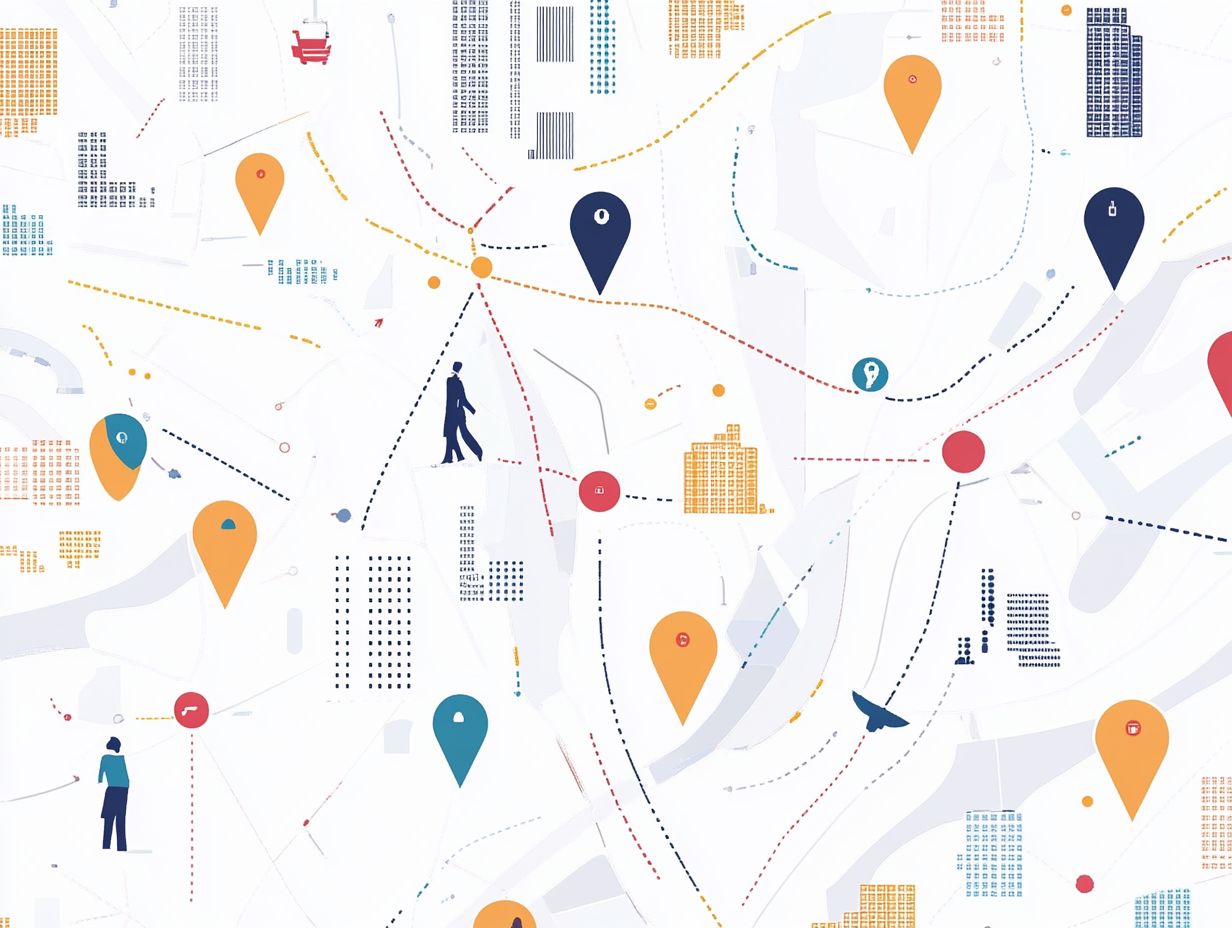In the ever-evolving landscape of retail, understanding customer behavior and consumer insights is more critical than ever.
Foot traffic, the measure of how many people enter your store, serves as a key indicator of retail performance and store visits.
This article explores the importance of foot traffic insights, offering retailers valuable tools to enhance their understanding of customer preferences, shopper engagement, and optimize their locations.
We discuss how to track and analyze this data, implement actionable changes, and share best practices that can transform your retail strategy.
Discover how leveraging foot traffic can elevate your business performance, improve store performance, and drive success across multiple locations.
What is Foot Traffic and Why is it Important for Retail Performance Tracking?

Foot traffic refers to the number of customers who visit a retail location over a specified period. It serves as an important retail metric in retail and is a valuable tool for optimizing store operations and store traffic analysis.
Retailers can leverage foot traffic data to gain insights into consumer behavior, assess sales performance, and inform decisions regarding site selection and marketing strategies. When combined with other key performance indicators, foot traffic metrics equip businesses with the tools necessary to identify trends, enhance customer engagement, and increase sales while ensuring efficient operations across multiple locations.
In fact, research indicates that a 10% increase in foot traffic correlates with an approximate 5% rise in sales. To measure foot traffic, retailers commonly use:
- Footfall counters
- Mobile data analytics
- Customer surveys
Analyzing foot traffic trends can reveal peak shopping hours, product placement preferences, and seasonal trends, allowing retailers to fine-tune their marketing initiatives. Furthermore, the relationship between foot traffic and sales often shows strong correlations, enabling retail management to make informed decisions regarding staffing, inventory management, and enhancements to the overall customer experience.
Benefits of Tracking Retail Performance with Foot Traffic Insights and Location-Based Analytics
Tracking retail performance through foot traffic insights offers retailers valuable customer information, aids in competitive analysis and benchmarking, identifies underperforming locations, assesses the effectiveness of marketing and promotions, informs store layouts, and ultimately enhances overall sales performance and operational efficiency.
Improved Understanding of Customer Behavior and Preferences
Foot traffic provides retailers with valuable insights into customer behavior and preferences, which is essential for developing effective retail strategies. Conducting an in-depth analysis of shopper insights, combined with demographic profiling and traffic analytics, enables businesses to enhance the experience for their target audience. This approach fosters customer loyalty by facilitating more engaging interactions and aligning promotional activities more closely with consumer needs.
Customer Behavior Insights through Foot Traffic Patterns

Shopping frequency can reveal peak times when customers are likely to be in-store, allowing for improved staff scheduling and inventory management.
Understanding Product Preferences through Foot Traffic Patterns
Whether a product is positioned at the front of the store or is a seasonal item, understanding which products attract more foot traffic can assist retailers in optimizing their merchandising strategies.
Identifying Changes in the Customer Base through Foot Traffic Patterns
If a retailer observes a spike in visits from young families, they may be prompted to increase inventory or enhance merchandising efforts for children’s products.
Identifying High-Performing and Underperforming Locations

Analyzing foot traffic enables retailers to identify which locations are performing well and which are not, offering critical insights for strategic planning and site selection. By cross-referencing sales performance and occupancy rates across various regions, businesses can conduct competitive analyses and performance benchmarking.
This approach to foot traffic analysis allows for the reallocation of resources, optimizing store operations and enhancing the overall retail strategy while maximizing ROI across multiple locations.
Understanding the specific demographics, local competition, and seasonal trends that influence performance levels can help decision-makers craft strategies tailored to the unique needs of each storefront.
For underperforming locations, implementing increased marketing efforts, improving product assortments based on local preferences, and redesigning store layouts can help regain customer interest.
In contrast, for successful sites, further leveraging these advantages may include expanding the product range, introducing loyalty programs, or forming partnerships with local businesses.
By utilizing location analysis to gain such insights, retailers can create a more resilient and adaptive ecosystem that thrives in diverse market environments.
How to Use Foot Traffic Insights for Retail Performance Tracking
Utilizing foot traffic insights for retail performance tracking involves employing data analytics to measure sales performance and operational efficiency.
Retailers can implement location tracking systems that capture traffic patterns and footfall measurements. This approach enables the analysis of customer visit metrics and behaviors. By applying predictive analytics to traffic data, retailers can forecast future traffic trends.
Consequently, this allows them to make data-informed decisions regarding staff scheduling, inventory levels, and promotional activities based on anticipated customer traffic patterns.
Setting Up Tracking Systems and Collecting Data
Establishing effective tracking systems and collecting data is one of the most crucial steps for leveraging foot traffic insights to enhance retail performance. Retailers have a wide range of methods at their disposal, from hardware solutions like CCTV cameras and infrared sensors to software platforms that analyze point-of-sale data and customer behavior, allowing them to choose based on their specific needs.
Ensuring data accuracy is vital, as it directly impacts the quality of the insights generated from the collected information. Businesses that utilize data visualization tools can transform complex datasets into easy-to-understand graphics, providing clear insights into peak shopping hours, periods of inadequate staffing, and customer flow patterns.
This clarity enables retailers to adjust their operational and marketing strategies, ultimately improving efficiency and customer satisfaction.
Analyzing and Interpreting Foot Traffic Data

Analyzing and interpreting foot traffic data is essential for understanding traffic patterns and generating actionable insights that can enhance retail performance.
By examining these patterns in detail, retailers can gain valuable insights into customer behaviors, preferences, and the times when they are most likely to visit a location. With this information, retailers can develop better operating strategies, work more efficiently, and improve the overall customer experience.
For instance, comparing foot traffic data with specific promotions or merchandising setups can reveal which offers are most effective in attracting customers. This enables retailers to dynamically adjust their sales strategies to remain competitive in a rapidly evolving marketplace.
Continuous monitoring of key performance indicators (KPIs) not only helps identify growth opportunities but also refines the entire decision-making process, ultimately leading to increased profitability and enhanced customer satisfaction.
Implementing Changes Based on Insights
Improvements in retail performance and operational efficiency can be achieved through the use of foot traffic data, which provides actionable insights to inform retail strategy, optimize store layouts, and manage customer traffic. Continuous improvement is possible when operational practices are aligned with these insights, a critical factor for success in the rapidly evolving retail landscape.
For instance, analyzing peak foot traffic times enables management to adjust staffing levels, ensuring that customer service remains unaffected during busy periods. Additionally, store layouts can be optimized by placing high-demand items near the exit, encouraging customers to make quick purchases.
Marketing strategies can also be developed using foot traffic data, such as implementing weekly promotions on days when foot traffic is typically higher.
Successful improvements rely on ongoing assessment and adjustment, with strategies being regularly evaluated and refined to ensure they continue to achieve the desired results.
Best Practices for Utilizing Foot Traffic Insights
Best practices for utilizing foot traffic data are essential for enhancing performance tracking and optimizing a retailer’s strategy.
Advanced retail technology and traffic analytics give the power to retailers to segment their customers and tailor their marketing efforts to specific demographics.
Regularly benchmarking performance against industry standards helps retailers remain competitive and continuously refine their operational metrics, ultimately improving efficiency and customer satisfaction.
Consistency in Data Collection and Analysis
Consistency in data collection and analysis is essential for obtaining accurate insights into foot traffic and effectively tracking retail performance through location insights and in-store analytics.
Retailers should establish standardized procedures for data collection to ensure that operational efficiency and actionable insights remain reliable for optimizing foot traffic and understanding customer journey.
Implementing a systematic approach that leverages technology to automate data collection can significantly enhance accuracy by minimizing human error, while enabling advanced traffic analysis and spatial analysis.
This approach enables businesses to benchmark their performance metrics against one another over time, allowing them to identify retail metrics trends and pinpoint areas of concern or improvement through comprehensive data analysis.
The consistent monitoring of these key performance indicators (KPIs) not only enhances operational efficiency but also gives the power to retailers to adjust strategies and make informed decisions based on real-time insights, improving store performance through predictive analytics.
Collaboration between Store Operations and Marketing Teams
Collaboration between store operations and marketing teams is essential for maximizing the impact of foot traffic insights on retail performance, particularly in understanding traffic patterns and visitor demographics.
By sharing customer insights and data on shopper behavior, these teams can align promotional strategies more effectively and create a more cohesive customer experience. This collaboration enhances business performance while deepening the understanding of customer demographics and market trends, ultimately leading to better-knowledge-based decision making.
For instance, a leading apparel retailer successfully integrated the capabilities of its visual merchandising and digital marketing teams to develop an advertising campaign that encouraged social media engagement while promoting limited-time offers in stores, leveraging digital signage and omnichannel retail strategies.
As a result, there was a significant increase in foot traffic during promotional periods, showcasing how aligned strategies can effectively engage shoppers and improve conversion rates and footfall measurement.
Furthermore, utilizing loyalty program data alongside store operations enabled retailers to better align inventory and promotions with current consumer activity, highlighting the crucial role of cross-departmental collaboration in enhancing retail strategy and customer engagement, using insights from store traffic analysis and in-store analytics.






